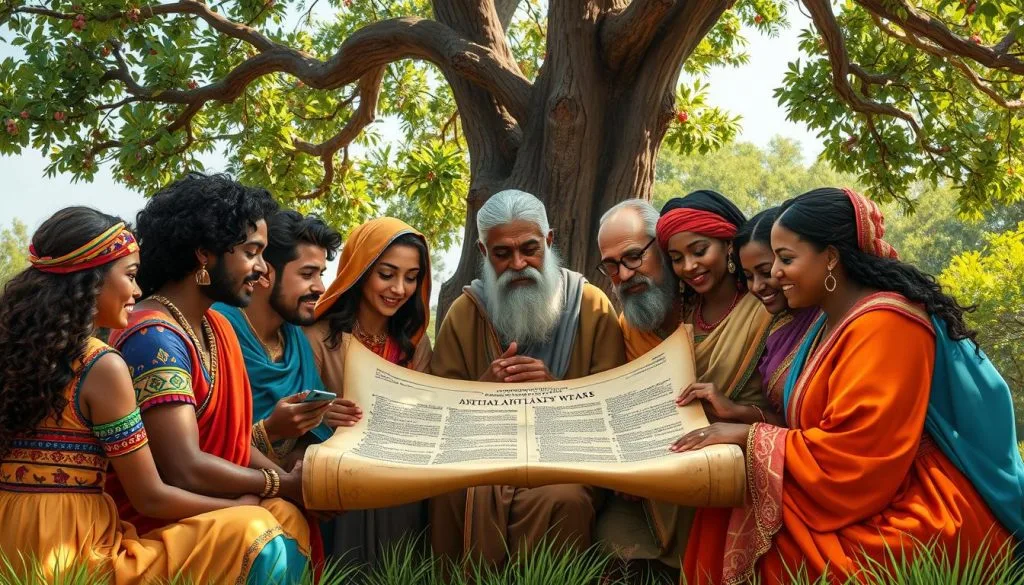Imagine a world where kids of color see themselves in the Bible’s stories. This is not just a dream but a real chance to change how we tell biblical stories. Before 1900, 84% of African American literature used biblical imagery. This shows how faith, identity, and the Black experience are deeply connected.
In this article, we’ll look at how writers like Paul Laurence Dunbar and Frances Harper used the Bible in their work. They critiqued society’s wrongs and brought comfort to their communities. By linking their struggles to biblical stories, they turned words into a powerful tool for fighting back and staying strong.
Key Takeaways
- Biblical imagery is common in African American literature, showing themes of faith, suffering, and hope.
- Writers use biblical references to speak out against injustice and offer spiritual comfort to their communities.
- The use of biblical narratives is a way to resist, connecting personal experiences with biblical stories.
- Images like the ‘Promised Land’ and Exodus are used to symbolize hopes for freedom and redemption.
- Biblical imagery creates a shared cultural language that deeply resonates in African American communities, linking past struggles to today’s realities.
The Importance of Storytelling in Faith Formation
Storytelling is a key tool in faith formation. It helps children connect with their cultural heritage. They see themselves in biblical stories. This makes a big difference in their identity, sense of belonging, and spiritual growth.
Connecting Children to Their Cultural Heritage
Religious texts like the Bible, Quran, and Bhagavad Gita share cultural themes. For African American children, these stories teach patience, forgiveness, and redemption. These lessons match their life experiences.
The Power of Representation in Biblical Narratives
The story of Jesus with a young child is in Mark, Matthew, and Luke. This shows children’s importance in the Bible. It deeply affects a child’s sense of belonging and spiritual identity.
By using diverse stories, faith leaders help children see themselves in sacred texts. This strengthens their connection to their culture and faith.
“Spiritual narratives play a pivotal role in conveying beliefs, morals, and values between generations, ensuring the continuity of key spiritual teachings within different religious communities.”
https://www.youtube.com/watch?v=klkEKMTe3OY
In conclusion, storytelling is crucial in faith formation. It uses diverse narratives that reflect children’s cultural heritage and experiences. This inspires a deep sense of identity, belonging, and spiritual growth in the next generation.
Embracing Diversity in Biblical Stories
Creating an inclusive space for all children is key. Embracing diversity in biblical stories is crucial. It helps us understand and appreciate the many facets of faith and identity.
The Bible celebrates God’s diverse people. Galatians 3:28 says we are all one in Christ, regardless of background. Jesus welcomed everyone, and the body of Christ in 1 Corinthians 12 shows unity in diversity.
The Book of Belonging shows the power of diverse stories. It has 42 stories from the Bible, with vibrant illustrations. These pictures show different body types, ages, and skin colors, celebrating inclusivity.
| Representation in the Book of Belonging | Description |
|---|---|
| Diverse Narratives | The book has 42 Bible stories, with 20 from the Old Testament and 22 from the New Testament, emphasizing a wide range of narratives. |
| Inclusive Illustrations | The illustrations depict a variety of body shapes, ages, abilities, and skin colors, reflecting the diversity of God’s people. |
| Authentic Representation | The book presents historically accurate depictions of Jesus and God’s people, using original Hebrew and Greek names for authenticity. |
By embracing diversity, the church welcomes everyone. This approach deepens our faith understanding and celebrates our cultural heritage. It highlights the unique contributions each person makes.
“There is neither Jew nor Gentile, neither slave nor free, nor is there male and female, for you are all one in Christ Jesus.” – Galatians 3:28
Engaging with diverse communities enriches our faith. Through conversations and cultural exchange, the church promotes harmony and respect. It’s a vital role in fostering unity.

Bible Identity Stories: Exploring Narratives of Black Identity
As we explore the Bible, we find stories that deeply connect with Black identity and faith. Scholars have shown that the Bible is not just about White people. It includes many Black figures, changing how we see biblical history.
Dr. Theron D. Williams says that everyone from Adam to Paul was Black. He believes the Bible starts in Africa, showing that biblical Hebrews came from Africa. The Bible often talks about Ethiopia, Egypt, and Israel, showing Africa’s big role in biblical history.
Before the Suez Canal was built in 1859, Israel was seen as part of Africa. This fact challenges the idea that Judeo-Christian history is all about Europe. The author says Israel’s people don’t really connect to European Jews, questioning the common view of biblical history.
| Statistic | Value |
|---|---|
| Dr. Theron D. Williams’ work asserts that people of the Bible, from Adam to Paul, were individuals of color, specifically Black people. | – |
| The book emphasizes the idea that the biblical narrative initiates in Africa, presenting biblical Hebrews as direct descendants of Africans. | – |
| References to Ethiopia, Egypt, and Israel are significantly more frequent in the Bible compared to mentions of other geographical regions during biblical times. | – |
| Before the Suez Canal’s construction in 1859, Israel was considered part of Northern Africa. | – |
| The author argues that Israel’s population lacks a connection to European Jews’ repatriation. | – |
Looking into these black identity stories in the Bible helps us understand their power. They inspire and uplift the next generation of Black believers. These stories show the importance of Black identity in sacred history, through cultural representation and faith.
Teaching the Story of the Exodus
The story of the Exodus is very important for the African-American community. It shows how the Israelites’ journey is similar to the African-American experience. This helps us teach the story in a way that Black children can relate to.
Connecting the Israelites’ Journey to the African-American Experience
The Exodus story speaks to the African-American community in many ways. Like the Israelites, African Americans have faced slavery, oppression, and the long journey to freedom. By focusing on themes like liberation, faith, and perseverance, we can show children the connection between the story and their heritage.
The Storyteller series offers a structured way to engage with the Exodus story. It includes five short daily readings each week. The Storyteller – Exodus book explores the first 15 chapters, highlighting the significance of this text in the biblical narrative of redemption.

Through the Storyteller series, children can also explore other biblical stories that reflect Black identity. Stories like Jonah, Job, and Ruth help discuss themes of suffering, purpose, faithfulness, and freedom in a culturally relevant way.
“The Exodus story resonates with the African-American community on multiple levels. Like the Israelites, African Americans have endured the hardships of slavery, oppression, and the arduous journey towards freedom and self-determination.”
By helping children see themselves in biblical stories, we can deepen their connection to their cultural heritage and spiritual identity. This approach not only improves their understanding of the Exodus but also boosts their sense of belonging and representation in the Bible.
Retelling the Nativity Through a Black Lens
Looking at the Nativity story through a Black perspective can deeply engage kids. It helps them understand the story’s historical and cultural importance. By focusing on Black representation and cultural interpretation, we make the story more relatable and meaningful.
One way to retell the Nativity is to use an African-American or Afro-Caribbean style. This means showing the Holy Family as a Black family, with Jesus as a Black baby. The setting can also be changed to show the traditions and architecture of Black communities. This makes the story feel more real and connected to the audience.
“Retelling the Nativity story through a Black lens allows children to see themselves reflected in the timeless narratives of their faith, fostering a sense of belonging and pride in their cultural heritage.”
Another idea is to show the African roots of the Nativity story. This connects the Magi’s journey to African culture and faith. By doing this, we can show the story’s global and diverse nature. This challenges the usual Eurocentric views and promotes a more inclusive understanding.
Retelling the Nativity through a Black perspective is not about replacing the old story. It’s about adding more diversity and cultural interpretation to this beloved biblical story. By embracing different views, we can make kids’ spiritual and cultural experiences richer. This helps them connect more deeply with their faith and appreciate the rich diversity of the Christian tradition.
Fostering Spiritual Growth Through Culturally Relevant Stories
In today’s world, using stories from the Bible that kids can relate to is key. These stories spark their imagination and connect with their everyday lives. This way, they can dive deeper into their faith and find their spiritual identity.
Engaging Children’s Imagination and Lived Experiences
Children do best when they see themselves in the stories they hear. By sharing Bible tales that match their culture and life, churches and families can spark their curiosity. This leads to a more meaningful journey of spiritual growth.
- Look for biblically engaging stories with characters and settings that reflect the kids in your community.
- Help kids imagine themselves in the Bible stories, making a stronger bond with the culturally relevant stories.
- Start conversations that link the Bible’s challenges and victories to the kids’ own children’s ministry experiences.
By linking the Bible stories to kids’ real lives, you help them grasp and appreciate the Bible’s timeless wisdom.
“The Bible is not a book of history; it is a book of spiritual growth. It is a book of truth, not just facts.”
When you choose culturally relevant stories for your kids’ ministry, you see the Bible’s power. It brings faith and identity together, creating a lifelong love for God’s Word.
Resources for Diversifying Biblical Storytelling
Churches, families, and educators are looking to tell more inclusive biblical stories. They want these stories to reflect the world we live in. There are many resources out there to help with this, from books and curricula to videos and online content. These tools can make your storytelling more diverse and help kids connect with their heritage.
Recommended Books
- The Color of Compromise by Jemar Tisby: This book dives deep into how the church has dealt with racial issues. It offers ways to work towards healing.
- Rethinking Biblical Literacy by Yolanda Y. Smith: It shows why understanding the culture behind biblical stories is key. It focuses on stories from marginalized groups.
- The Bible in Black and White by Emerson B. Powery and Rodney S. Sadler Jr.: This guide explores how race and culture shape our view of the Bible.
Educational Curricula
- The Empowered: God’s Spirit, God’s People curriculum from the Evangelical Lutheran Church in America. It includes stories from diverse backgrounds and teaching tools.
- The Faithful Families program from the United Church of Christ. It helps families connect with Bible stories that reflect their culture.
- Building Bridges from the Presbyterian Church (U.S.A.). It looks at the experiences of people of color in the Bible. It encourages understanding and dialogue.
Multimedia Resources
There are also online and multimedia resources for diverse biblical storytelling:
- The Bible Project offers animated videos and educational content. It highlights the cultural and diverse aspects of the Bible.
- RightNow Media is a streaming platform with Bible studies and teaching resources. It includes content from diverse perspectives.
- The Amistad Resource Center is a digital library. It focuses on the African-American experience in the biblical narrative.
By using these resources, churches, families, and educators can make their biblical storytelling more inclusive. This can lead to a deeper understanding and appreciation of the diverse stories in the scriptures.
The Role of the Church in Promoting Inclusive Narratives
The church is key in sharing stories that include everyone. It makes sure all kids see themselves in the Bible, no matter their background. As we learn more about the power of stories, the church must share many voices and experiences in its teachings.
Thinkers like Johann Baptist Metz and Stanley Hauerwas show how stories shape who we are. They say we need to hear many stories to feel welcome. This way, the church can be a place where everyone feels at home, learning about the Bible together.
Bishop Robert Wright of the Episcopal Diocese of Atlanta leads by example. He wants churches to check if they truly follow Jesus’ teachings. He fights against using Christian symbols for political gain.
“The church must engage deeply with politics in a manner consistent with Jesus’s teachings and resist the co-opting of Christian symbols for partisan agendas.”
With Christian Nationalism growing, the church must stand for diversity and representation. By focusing on inclusive narratives in biblical education, the church helps kids connect with their faith and culture.
- Incorporate diverse perspectives and experiences in biblical storytelling
- Collaborate with community leaders and experts to develop culturally relevant curricula
- Provide training for teachers and clergy to facilitate discussions on diversity and representation in the Bible
- Actively promote inclusive narratives in church publications, events, and outreach efforts
- Advocate for the inclusion of diverse biblical narratives in Christian education materials and resources
By taking this step, the church can help create a more inclusive place for learning. It empowers the next generation to find their place in the rich world of faith.
Conclusion
This article has shown how Bible stories that reflect Black identity are powerful. They inspire the next generation. By embracing diversity and telling stories that are culturally relevant, we can help all children connect with their faith and culture.
Storytelling is key in shaping faith. Seeing ourselves in biblical stories changes us. Churches and families play a big role in sharing these stories. This way, the next generation can find their place in God’s story.
By celebrating the diversity in biblical characters, we understand God’s love better. This understanding is for everyone. As we share these stories, we inspire the next generation to grow in faith and make a difference in their communities.
FAQ
What is the importance of storytelling in faith formation for children?
Why is it important to embrace diversity in biblical stories?
What are some examples of Bible stories that reflect Black identity?
How can the story of the Exodus be connected to the African-American experience?
How can the Nativity story be retold through a Black lens?
What resources are available for diversifying biblical storytelling?
What is the role of the church in promoting inclusive biblical narratives?
Source Links
- Biblical imagery – (African American Literature – Before 1900) – Vocab, Definition, Explanations | Fiveable – https://library.fiveable.me/key-terms/african-american-literature-to-1900/biblical-imagery
- "Live Like It’s True" Bible Podcast – Shannon Popkin – https://www.shannonpopkin.com/bible-podcast/
- 2024 brings new LGBTQ Christian books and gifts – https://qspirit.net/lgbtq-christian-books-2024/
- Of Storytelling and Belief – Sermon for Proper 20, RCL Year B | That Which We Have Heard & Known – https://www.thefunstons.com/of-storytelling-and-belief-sermon-for-proper-20-rcl-year-b/
- Spiritual Narratives: Definition & Themes – https://www.vaia.com/en-us/explanations/religious-studies/spirituality/spiritual-narratives/
- Unity in Diversity: Embracing Everyone for the Sake of the Gospel – https://nextg.org/unity-in-diversity-embracing-everyone-for-the-sake-of-the-gospel/
- The Book of Belonging: Bible Stories for Kind and Contemplative Kids – https://snailonthewall.com/book/9780593580318
- Unity in Diversity: A Faithful Journey Through Multiculturalism – https://medium.com/@bgodinspired/unity-in-diversity-a-faithful-journey-through-multiculturalism-abe4f75d98b4
- The bible is black history pdf – https://assets.website-files.com/66004c2db5ae78d5557b4ca1/66f0df7421988f0754b575f8_71752650685.pdf
- identity – The PBS Blog – https://thepbsblog.com/tag/identity/
- Championing new narratives, identity, through Eelevate – https://thesun.ng/championing-new-narratives-identity-through-eelevate-africa-project-2/
- Storyteller | Lifeway – https://www.lifeway.com/en/product-family/storyteller-bible-study
- Twelve Tribes and Twelve Spies – https://missionbibleclass.org/old-testament/part1/exodus-through-12-spies/twelve-tribes-and-twelve-spies/
- Children’s Story Bible Highlights Sacred Belonging – https://www.calpacumc.org/stories/childrens-story-bible-highlights-sacred-belonging/
- LaurenRELarkin.com – https://laurenrelarkin.com/
- Joseph and the queer Biblical princess dress – https://qspirit.net/joseph-queer-biblical/
- Teaching Christian Biblical Worldview To Kids & Teens – https://tenminutemomentum.com/teaching-christian-biblical-worldview/
- A life in the Spirit – https://rodwhite.net/category/a-life-in-the-spirit/
- Blog – https://iamthewaybook.com/blog
- There is no Early American Literature without Native American Literature – Building Book Love – https://buildingbooklove.com/there-is-no-early-american-literature-without-native-american-literature/
- English Department – https://blogs.hope.edu/english/
- Donna Gawell – https://donnagawell.com/
- Exploring Ethical Potentials of Christian Narrative Testimonies – https://www.degruyter.com/document/doi/10.1515/opth-2024-0015/html
- Episcopal Bishop Challenges Christian Nationalism – Episcopal Diocese of Atlanta – https://episcopalatlanta.org/news/episcopal-bishop-challenges-christian-nationalism/
- The Model: Becoming More Like Christ – C.S. Lewis Institute – https://www.cslewisinstitute.org/resources/the-model-becoming-more-like-christ/
- “I used to base my identity on the way I looked” – Grace Fisher’s Story – Sycamore Community Church – https://sycamore.church/i-used-to-base-my-identity-on-the-way-i-looked-grace-fishers-story/
- My Story: Finding Eternal Assurance – HISsparrowBlog – https://hissparrowblog.com/my-story-finding-eternal-assurance/
